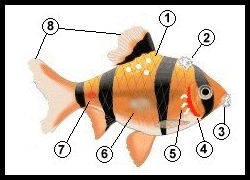|
Probably one of the most distressing times of your aquarium with you and your fish, will
be when your fish are ill. I mean, there you are, proud of your new
fish and aquarium and - bam!! Your fish are covered in spots, or
wool-like, small tufts on the body. Your mind will be racing, and thinking things like: What the hell is that
stuff? Is it incurable? Will it infect all the other fish? is
this game over for all of my fish? Yes, its a worrying time, thats for
certain. So to help you to catch an illness quickly, here are a few
(only a few, there are hundreds of diseases around) of the more
common tropical freshwater fish diseases
Examples of fish diseases

To see an example of a Healthy Fish.
| Symptons of illness |
It could be... |
Treatment |
| Your new fish have died - there are no obvious signs of illness |
"New Tank Syndrome"
|
Adding fish to a brand new aquarium stresses the fish, and sometimes it can be fatal. For more info, check out: The Nitrogen Cycle |
| Loss of appetite |
An enviromental problem, newly-introduced fish can be slow to feed (stress), certain fishes will refuse anything but live foods.
|
Enviromental: inspect for any manifestations of disease, and get a basic water tester (Ammonia etc). The same with stress. Be patient with them. Look for other signs of disease. |
| 2,3) Cotton Wool effect on the body |
Fungus, Columnarius (Mouth fungus)
|
If you see this disease, can use medication (ie "Anti Fungus") and a Salt bath (1 teaspoon per gallon) |
| 1) Small, white spots on the head, body and fins. |
Whitespot (Ichthyophthirius)
|
A very common disease (especially in a new aquarium). There are several formulas around, dose the fish quickly before the parasite spreads. Salt could be used (1 teaspoon per galloon). |
| 8) Fraying of the soft tissue (fin membrane) |
Fin Rot, the disintegration of the fins
|
Use medication before a secondary infection occurs, it will take several days before there is serious fin damage. Could use salt bath (1 teaspoon per gallon) |
| Appearance of a whitish film over the eye of the fish |
Poor water quality, poisoning (Chlorine) or Eye Fluke
|
Poor water: Water changes are required. Poisoning: Make sure to condition tap water. Eye Fluke: Use medication |
| 4) Fish are gasping, on the bottom of the aquarium, red streaks around gills |
Most probably oxygen starvation, or a Gill disease
|
You have too many fish, an air punp may help. Gill diseases are quite rare, you could actually see the gills rot away: use medication. |
| 5) Worms are visibly seen hanging from the gills, fish are gasping |
Gill Worm (Dactylogyrus)
|
This is another parasite. Use anti-parasite drugs as directed. |
| 7) Reddining of the skin, or red streaks in the fins |
Virus, Ulcers (Bacterial infection)
|
Viruses can only be seen through microscopes - and its incurable. With a bacterial disease, use a anti-bacteria or anti-internal treatment. A prolonged SALT bath (3-5 g/litre for several days) will alliviate osmoregulatory stress in the case of severe ulceration. |
| Scales seem to be raised, fish are bloated. |
Dropsy (Ascites)
|
Dropsy is more of a sympton than an actually disease yet, and is quite common. Most associated with a bacterial infection (cause could be wide - poor water conditions are often the culprit. Meds can be used, but dont always work. |
| Small, worm like parasites attached to fish, fish scraping against rocks. |
Anchor worm (lernea)
|
There are many Crustacean Parasites around, and can be exported into your water. Meds are available. |
| 6) Dull colour (mucus), detached skin, fraying of the fin. |
Mucus Hyperproduction.
|
This called by caused by Slime disease (parasite, meds available), poor water conditioners (high Nitrogenous wastes), fFukes, stress. |
A word of warning with using medication: Obviously people want to save their fish, so
they go and buy a product, and sometimes these can be quite effective. But a word of
warning - some meds can be very detrimental in the long term. Treatments whitch use Malachite
Green and Methylene Blue can be useful treatments for parasites and Fungus, unfortunately they can destroy
our beneficial bacteria, and then you can get a Ammoni/Nitrite peak for some time. Also some meds
demand it that they remove Carbon/Zeolite for the duration of the treatment - this can effectively
start up a mini-cycle as the Carbon/Zeolite have lost their bacteria.
Salt bath: So a salt bath is a good way of treating the fish without damaging the bacteria we need.
It is a good antiseptic and fungicide. If you are using high doses, its best to try to gradually
raise the concentration, so the fish don't become stressed. Sometimes it can be effective to use a short salt bath, with higher
salt concentration (such as fungal infection - 10G/Litre for 30 min).
|







